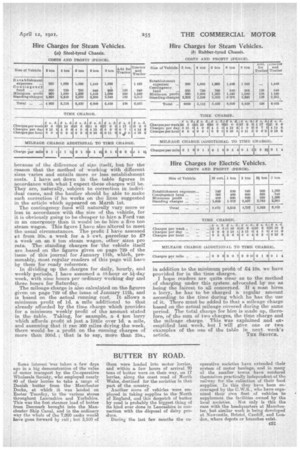HINTS FOR HAULIERS.
Page 26

Page 27

If you've noticed an error in this article please click here to report it so we can fix it.
An Occasional Chat on Subjects and Problems of Interest to those Who are Engaged, or About to be Engaged, in Running Commercial Vehicles for a Living.
IMUST now endeavour to set out a scale of charges for the hire of various sizes of vehicle. I propose, in the first instance at least, to work on the same lines as those explained last week in connection with a four-tonner, in which I based the charges separately, according to the time the lorry was engaged and the mileage covered, the charge for time and the charge for mileage being ultimately added together in order to arrive at the complete account. I have tabulated my calculations under the accompanying schedules, and have there set out allowances for establishment expenses, contingency fund, minimum profit, and standing charges (of vehicle); these are items of expense which are incurred by the haulage contractor whether his vehicle be running or not, and his charges for time must, therefore, be based on this. In the next line of the tables I have totalled the above Charges. This total
Hire Charges for Petrol Vehicles. (a) Solid-tyred Chassis. COSTS AND PROFIT (PENCE).
gives the minimum per week which the haulier must charge if he is going to make the minimum profit which we have scheduled, hi the next line I have reduced this figure to an even amount, which I have given as the actual charge per week which should be made. The remainder of each table is selfexplanatory.
It may be as well to explain how I have arrived at some Of the figures. I must do this in reference to the example which I gave last week in connection with a four-tonner. The three principal items are there given as establishmentcharges, contingency fund, and profit. The method of arriving at the establishinent charges was given in a previous article (March 1st). These charges will vary to some extent for different sizes of vehicle, not necessarily
Hire Charges for Petrol Vehicles.
(b) Pneumatic-tyred Chassis. COSTS AND PROFIT (PENCE). because of the difference of size itself, but for the reason that the Method of working with different sizes varies and entails more or less establishment costs. I have set down in the table figures in accordance with what I expect these charges will be. They are, naturally, subject to correction in individual cases, and the haulier should be able. to make such correction if ha works on ;he lines suggested in the article which appeared an March 1st.
The contingency fund_ will naturally vary more or less in accordance with the size of the, vehicle, for it is obviously going to be cheaper to hire a Ford van in an emergency than it would be to hire a five ton steam wagon. This figure I have also altered to meet the usual circumstances. The profit I have assessed it from 30s. a week for a 5 cwt. parcelcar to 21 a week on an S ton steam wagon, other sizes pro rata. The standing charges for 'the vehicle itself are based on the figures given on page 729 of the issue cif this journal for January 11th, which, presumably, most regular readers of this page will have by them for ready reference. In dividing uip the charges for daily, hourly, and weekly periods, I have assumed ..a, 48-hour or 5-i-day week, with nine hours per ordinary working day and three hours for Saturday.
The mileage charge is also calculated an the figures given on page 729 of the issue of January 11th, arid is based on the actual running cost. It allows a minimum profit of id. a mile additional to that already afforded by the time charge which provides for a minimum weekly profit ot the amount stated in the table. Taking, for example, a 4 ton lorry which affordsprofit at just a, little over id. a mile, and assuming that it ran 300 miles during the week, there would be a profit on the running charges of more than 300d. ; that is to say, more than 25s.,
in addition to the minimum profit, of .E4 10s. we have provided for in the: time charges.
I hope readers are quite clear as to the method of charging under this system advocated by me as being the fairest to all concerned. If a man hires a lorry, he has to be charged a regular amount aoc.ording to the time during which he has the use of it. There must be added to that a mileage charge based on the actual mileage covered during the same period. The total charge for hire is made up, therefore, of the sum of two charges, the time charge and the mileage charge. This was explained and ex-, ernplified last week, but I will give. one or two examples of the use of the table in next week's
































